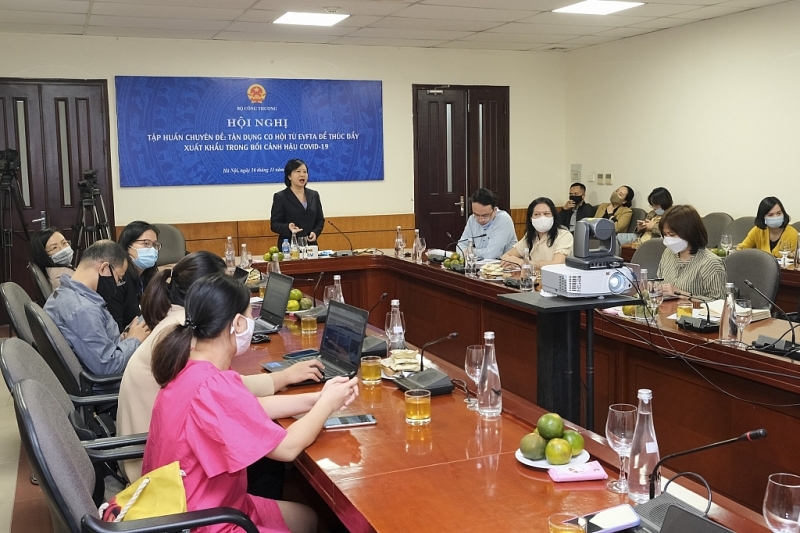 |
| Overview of the training conference on the morning of November 16, 2021. Photo: NT |
At the training conference on “Using the opportunity of the Vietnam-EU Free Trade Agreement (EVFTA) to promote exports in the post-Covid-19 context” organized by the Import-Export Department, the Trade Remedies Administration in collaboration with the Office of the Ministry of Industry and Trade held on the morning of November 16, 2021, Ms. Trinh Thi Thu Hien, Head of the Origin of Goods Department, Import-Export Bureau shared many stories of the issue of origin for Vietnamese export goods.
A typical example mentioned by Ms. Hien was a textile shipment from the same factory, with the same products, the same input materials and output products, but exported to different markets such as Singapore, the EU and Canada.
For the Singapore market, these goods met Vietnam’s origin because Singapore was a member of ASEAN and within the ASEAN framework, the rules of origin for textiles and garments only needed to be cut and sewn into clothes, then the finished garment can be considered Vietnamese origin and was entitled to preferential treatment.
However, these goods, when exported to the EU, required the origin from fabric onwards. This meant that the two-stage rule, the weaving, cutting and sewing of clothes must be carried out in the member countries of the EVFTA to enjoy tariff preferences within the framework.
When exporting to Canada, the rules of origin under the Comprehensive and Progressive Agreement for Trans-Pacific Partnership (CPTPP) were from yarn onwards. That meant that the stages of spinning, weaving into fabric and cutting and sewing into clothes must all be done in CPTPP member countries to enjoy incentives.
“There will be a story that exports from the same factory, when applying for a Certificate of Origin (C/O) in ASEAN, the organizations of the Ministry of Industry and Trade will still issue it normally, but when issuing C/O to the EU, it does not meet the requirements and the shipment does not meet the criteria to be considered as originating in Vietnam. The origin of Vietnam also depends on the commitment, market, and products,” emphasized Ms. Hien.
Ms. Hien added that in the process of determining the origin of Vietnamese goods, there were also many problems. A typical example was exporting wood products of a famous Vietnamese company to Japan.
This shipment was wooden spice jars but has some plastic or porcelain parts. At the port of Tokyo, written on the C/O was the wooden products, but the Tokyo Customs office said that they were plastic products even though all other parts were wooden, only the inside of the box was made of plastic and they asked the C/O issuing authority to determine whether the plastic product met the requirements.
However, the same shipment arrived at the port of Osaka in Japan was confirmed to be porcelain products because the outer shell was porcelain, the rest of the details were made of wood. After that, the Import-Export Bureau had to contact the Customs office, which was the focal point of Japan, to agree on a regulation, the company had to redo the application.
 |
| In the process of carrying out export procedures, enterprises need to pay attention to all the steps, even the smallest details. Photo: Nguyen Thanh |
Another story cited by Ms. Hien was the writing on the C/O.
According to regulations, C/O must be written in English, but a case in Hai Phong when exporting limestone to Malaysia, on C/O written as “da voi” (translated in English into “elephant skin”), when exporting quicklime, they wrote “voi song” (translated in English into “live elephant”). Fortunately, both “voi song” and quicklime were goods of pure origin with the same origin and weight criteria, so they met export standards.
However, the Malaysian Customs agency contacted the Ministry of Industry and Trade with information that it was not possible to find in the list of goods which items are “voi song”.
After that, the Ministry suggested that enterprises amend their C/O, because the post-customs clearance inspection period could be 2 to 3 years, even 5 or 10 years. Maybe at the time of import they didn’t make it difficult, but after two years they pulled back the C/O and asked for verification.
“Vietnamese enterprises are not only caught with errors related to the origin of goods but sometimes just procedural errors. In the process of carrying out export procedures, enterprises need to pay attention to all the stages, even the smallest detail,” said Ms. Hien.
